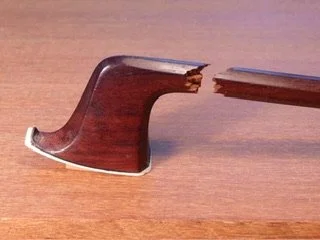🎻 Caring for Your Bow: A Guide for String Players
By Cantabile Fine Bows
A fine bow is more than just a tool — it’s a partner in your playing. Whether you own a 19th-century French bow or a contemporary maker’s work, caring for your bow properly ensures it performs at its best for years to come.
Firstly - Be Careful When Removing Your Bow from the Case!
One of the most common – and easily avoidable – ways to break a bow is by pulling it out of the case too quickly. The bow tip (or “head”) can catch on the edge of the case, especially in cases where the bow holders are snug or misaligned. A sudden tug can cause the stick to snap just behind the head – a notoriously weak point. Always take a moment to guide the bow out gently, making sure it clears the case interior without catching.
Protecting the Handle with Leather or Lizard Grip
Over time, the area where your hand contacts the bow – just above the frog – can wear down from constant use. Adding a leather or lizard-skin grip not only preserves the original winding and stick underneath, but also provides better traction and comfort while playing. This small addition can significantly extend the life of the bow and is particularly worthwhile for older or historically important bows where preserving original materials matters.
Here are some further tips to help keep your bow in top condition:
🧼 1. Clean Off Rosin Regularly
After each practice or performance, gently wipe your bow stick and frog with a soft, dry cloth to remove excess rosin.
Avoid touching the hair — natural oils from your fingers can degrade it.
Don’t use alcohol cleaners - especially near the varnish.
Tip: Use a separate cloth just for your bow to avoid transferring rosin from the violin.
🔄 2. Loosen the Hair After Playing
Always loosen your bow when you’re finished playing. Leaving it tightened can cause:
Warping of the stick
Loss of camber (the bow’s natural curve)
Hair overstretching
Only tighten until there’s a gentle curve and enough clearance between the hair and stick when playing.
🌡️ 3. Watch Temperature and Humidity
Bows are sensitive to environmental changes.
Avoid leaving your bow in a hot car, cold room, or direct sunlight.
Use a case with a humidifier during dry months.
In summer, watch for hair expanding and going slack — don’t overtighten to compensate.
🎯 4. Rosin Wisely
Use only as much rosin as needed.
Too much = scratchy tone and dust buildup
Too little = lack of grip and clarity
Apply rosin evenly from frog to tip — and never force it.
🪛 5. Schedule Rehairs Regularly
Hair loses bite over time, even if it looks fine. Consider a rehair:
Every 6–12 months for regular players
After intense humidity swings or heavy use
If you notice uneven tension or a dull sound
Pro tip: Ask your luthier or bow maker for a rehair schedule based on your climate and usage.
🧳 6. Travel with Care
Always use a sturdy case with proper support for your bow.
Avoid loose bow holders or exposed hair
Never pack your bow in soft luggage or near sharp objects
For flights, keep it in carry-on luggage
🧠 7. Seek Expert Help for Repairs
If your bow gets scratched, chipped, or warped — don’t attempt DIY fixes. An experienced bow maker or restorer can preserve both function and value.
🏷️ Thinking of Investing in a Fine Bow?
At Cantabile Fine Bows, we offer carefully curated bows for every level — from collectors to advanced students. We also offer UK trials, expert advice, and ongoing support after your purchase.
📩 Have questions about caring for your current bow?
Contact us — we’re always happy to help.

